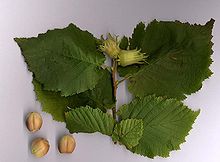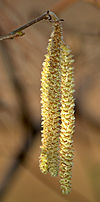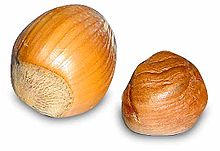- Corylus avellana
-
Corylus avellana 
Common Hazel leaves and nuts Conservation status Scientific classification Kingdom: Plantae (unranked): Angiosperms (unranked): Eudicots (unranked): Rosids Order: Fagales Family: Betulaceae or Corylaceae[1] Genus: Corylus Species: C. avellana Binomial name Corylus avellana
L.Corylus avellana, the Common Hazel, is a species of hazel native to Europe and western Asia, from the British Isles south to Iberia, Greece, Turkey and Cyprus, north to central Scandinavia, and east to the central Ural Mountains, the Caucasus, and northwestern Iran.[2][3][4] It is an important component of the hedgerows that were the traditional field boundaries in lowland England. The wood was traditionally grown as coppice, the poles cut being used for wattle-and-daub building and agricultural fencing.
Common Hazel is cultivated for its nuts. The name hazelnut applies to the nuts of any of the species of the genus Corylus. This hazelnut or cob nut, the kernel of the seed, is edible and used raw or roasted, or ground into a paste. The cob is round, compared with the longer filbert nut.
Contents
Description, ecology and nomenclature
Common hazel is typically a shrub reaching 3–8 m tall, but can reach 15 m. The leaves are deciduous, rounded, 6–12 cm long and across, softly hairy on both surfaces, and with a double-serrate margin. The flowers are produced very early in spring, before the leaves, and are monoecious with single-sex wind-pollinated catkins. Male catkins are pale yellow and 5–12 cm long, while female catkins are very small and largely concealed in the buds with only the bright red 1–3 mm long styles visible. The fruit is a nut, produced in clusters of one to five together, each nut held in a short leafy involucre ("husk") which encloses about three quarters of the nut. The nut is roughly spherical to oval, 15–20 mm long and 12–20 mm broad (larger, up to 25 mm long, in some cultivated selections), yellow-brown with a pale scar at the base. The nut falls out of the involucre when ripe, about 7–8 months after pollination.[2][4][5]
It is readily distinguished from the closely related filbert (Corylus maxima) by the short involucre; in the filbert the nut is fully enclosed by a beak-like involucre longer than the nut.[2]
The leaves provide food for many animals, including Lepidoptera such as the case-bearer moth, Coleophora anatipennella. Caterpillars of the concealer moth, Alabonia geoffrella, have been found feeding inside dead common hazel twigs. See also List of Lepidoptera that feed on hazels.
The fruit are possibly even more important animal food, both for invertebrates adapted to circumvent the shell (usually by ovipositing in the female flowers, which also gives protection to the offspring) and for vertebrates which manage to crack them open (such as squirrels and corvids).
The scientific name avellana derives from the town of Avella in Italy,[6] and was selected by Linnaeus from Leonhart Fuchs's De historia stirpium commentarii insignes (1542), where the species was described as "Avellana nux sylvestris" ("wild nut of Avella").[7]
Cultivation and uses
The Common Hazel is a shrub common in many European woodlands. It is an important component of the hedgerows that were the traditional field boundaries in lowland England. The wood was traditionally grown as coppice, the poles cut being used for wattle-and-daub building and agricultural fencing.[2] A selection with twisted branches has been propagated horticulturally as Corylus avellana 'Contorta'.
Hazelnuts
Main article: HazelnutThe hazelnut is the nut of the hazel, and is also known as the cobnut. It is roughly spherical to oval, about 15–25 mm long and 10–15 mm in diameter, with an outer fibrous husk surrounding a smooth shell. The nut falls out of the husk when ripe, about 7–8 months after pollination.
Hazelnuts are rich in protein and unsaturated fat. Moreover, they contain significant amounts of thiamine and vitamin B6, as well as smaller amounts of other B vitamins. Additionally, 1 cup (237 ml) of hazelnut flour has 20 g of carbohydrates, 12 g of which are fibre.[8]
There are many cultivars of the Hazel, including 'Barcelona', 'Butler', 'Casina', 'Clark' 'Cosford', 'Daviana', 'Delle Langhe', 'England', 'Ennis', Fillbert, 'Halls Giant', 'Jemtegaard', 'Kent Cob', 'Lewis', 'Tokolyi', 'Tonda Gentile', 'Tonda di Giffoni', 'Tonda Romana', 'Wanliss Pride', and 'Willamette'.[9] Some of these are grown for specific qualities of the nut including large nut size, and early and late fruiting cultivars, whereas other are grown as pollinators. The majority of commercial Hazelnuts are propagated from root sprouts.[9] Some cultivars are of hybrid origin between Common Hazel and Filbert.[5]
Common Hazel is cultivated for its nuts in commercial orchards in Europe, Turkey, Iran and Caucasus. The name "hazelnut" applies to the nuts of any of the species of the genus Corylus. This hazelnut or cobnut, the kernel of the seed, is edible and used raw or roasted, or ground into a paste. The seed has a thin, dark brown skin which has a bitter flavour and is sometimes removed before cooking. The top producer of hazelnuts, by a large margin, is Turkey, specifically the Ordu Province. Turkish hazelnut production of 625,000 tonnes accounts for approximately 75% of worldwide production.[10]
References
- ^ Fitter, R. and Fitter A., The Wild Flowers of Britain and Northern Europe (1978) 3rd Eds. William Collins & Sons Ltd, Glasgow
- ^ a b c d Rushforth, K. (1999). Trees of Britain and Europe. Collins ISBN 0-00-220013-9.
- ^ Den Virtuella Floran: map
- ^ a b Trees for Life Hazel species profile
- ^ a b Flora of NW Europe: Corylus avellana
- ^ Mitchell, A. F. (1982). The Trees of Britain and Northern Europe. Collins ISBN 0-00-219037-0
- ^ Linnaeus, C. (1753). Species Plantarum p. 998.
- ^ Nutrition Facts, Bob's Red Mill All-Natural Hazelnut Meal/Flour (Amazon.com)
- ^ a b Huxley, A., ed. (1992). New RHS Dictionary of Gardening. Macmillan. ISBN 0-333-47494-5.
- ^ World Hazelnut Situation and Outlook, USDA 2004.
External links
Categories:- IUCN Red List least concern species
- Corylus
- Flora of Asia
- Flora of Europe
- Least concern plants
- Trees of mild maritime climate
Wikimedia Foundation. 2010.



